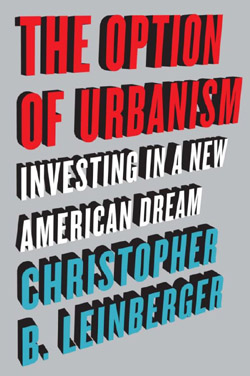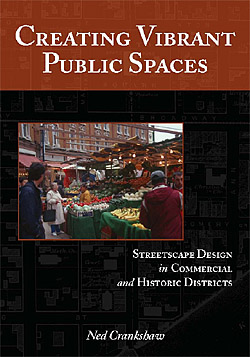
|
||
|
Issue 52 |
|
10 December 2008 |
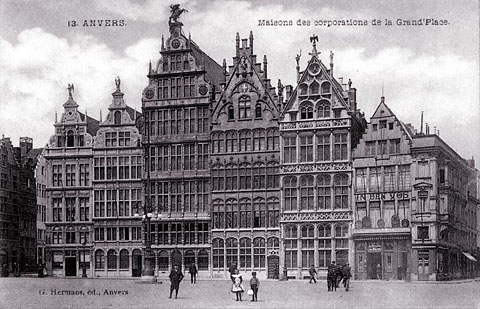 Antwerp
Announcements
Carfree Design Manual Is Finally Here!More than seven years after I set to work on it, the book was finally delivered to the publisher's warehouse on 21 November 2008. I have received a few copies, and I am very pleased with the final result. After months of slaving over color corrections, I am relieved that the color in the finished books is very satisfactory. The printer and binder did a fine job in all respects. The weight of the book is not as great as I had feared, although it's plenty hefty.The main shipment to the USA is coming by sea and is expected in mid-January. The official publication date is 1 April 2009. If you are in North America, the only way to get a copy sooner is to order it from the UK or from bol.com. The book can be ordered from the following vendors, and your local bookstore can also order it. Amazon USA, Amazon Canada, and Barnes & Noble will ship at the time of official publication, which is holding firm at 1 April 2009. Both Amazon US and Barnes and Noble are offering substantial discounts for pre-orders.
More information about the book is now available:
Foreword by Stavros Dimas, Member of the European Commission responsible for Environmental Protection Introduction [PDF!] Carfree Design Manual home page Technical Details Internet Orders Wholesale Orders Feature ArticleI offer Barack Obama a plan for a sustainable American future. The nation and the world are at a crossroads. It really is time for change. See below.ThanksI would like to thank all those who assisted in some way with the production of Carfree Design Manual. Without the help of dozens of people this book would never have reached its final form.Thanks also to the many stringers who have forwarded stories to Carfree Times. I no longer name people for fear of slighting someone by overlooking a name. New ArticlesOn Photography is an introduction to the craft of photographing cities. |
|
 Florence |
A Century AgoWe continue our tour of cities from a century ago, as seen through the eyes of photographers of the day. Their images are scattered throughout this issue.
News Bits Turin World Carfree Day Comes Around AgainComprehensive information on carfree day events has actually become more difficult to obtain even as the event has spread to thousands of cities and is enjoyed by millions of people. I will only touch on a few noteworthy events.TaiwanSome 30,000 Taipei residents, led by the mayor, celebrated 2008 World Carfree Day biking along a 16 km route. Officials had estimated that about 3,000 cyclists would participate, but the public response was overwhelming. Live music and free coffee were offered in the business district, where no private vehicles were admitted between 07:00 and 17:00. Free bus service was offered.In the central city of Taichung, 5,000 cyclists enjoyed riding on carfree streets. Prizes, including bikes, were awarded. In Kaohsiung, the mayor joined thousands of citizens in cycling along a 6.5 km route in this southern port city. A bridegroom pedaled to the cultural center to pick up his bride for their wedding. The mayor thanked the participants for responding to the call to spread the message of energy conservation and carbon emissions reduction for the sake of the environment. The city will create more than 150 km of cycle paths by the end of the year. New York's Summer Streets UpdateNew York's bike-friendly Transportation Commissioner, Janette Sadik-Khan, announced that August's street closures in Manhattan will be back. The Summer Streets program closed a 7-mile stretch from the Brooklyn Bridge to Central Park to traffic on three consecutive Saturdays. According to Sadik-Kahn, the event was "clearly a hit on Park Avenue." The Summer Streets program will almost certainly be extended to the other boroughs next summer.Some retailers complained of lost business, but cyclists and pedestrians were mostly enthusiastic about the carfree oasis. They played music, danced, and practiced yoga in the middle of major Manhattan thoroughfares. See Carfree Times #51 for a brief report of a Summer Streets event in Brooklyn.
"30,000 Taipei cyclists celebrate 2008 World Car-Free Day" 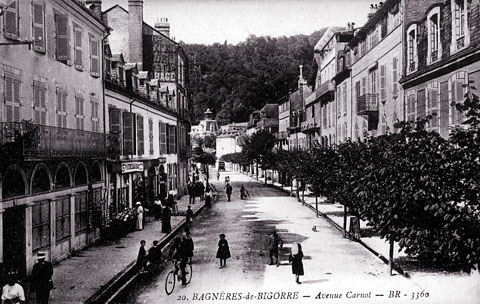 Bagneres-de-Bigorre University BikingCollege students arriving for the fall semester received a surprise on some campuses this year: a free bike. Not all of the efforts have been considered successful, but many students understand that biking is a great way to get around the campus. Administrators like the idea because the direct and indirect costs of parking have become a major concern. They are seeking to ease critical shortages of parking and to tone down the car culture that clogs campus roads and erodes the sense of community that arises when students walk or bike on campus. Administrators were concerned that their often-lovely campuses were becoming mostly asphalt parking lot. Health benefits are also expected.When the University of New England gave away 105 bikes in the first week of school, the number of freshmen arriving with cars plunged from 75% to 25% in one year. Rental programs have been established at several US universities.
There are problems. Bikes at some campuses were seen as toys, not transportation. Some programs have been afflicted by theft and vandalism. I question whether it is really necessary to give away $500 bikes just to noodle around campus.
"With Free Bikes, Challenging Car Culture on Campus"
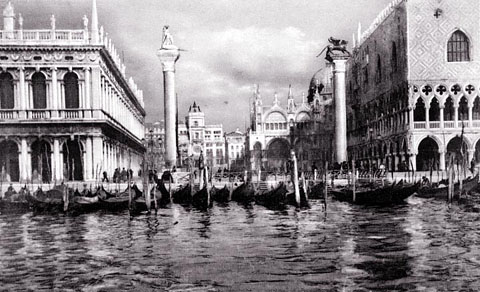 Venice Climate ForcingAn article in a recent issue of Science considered the crucial question of what effect warming has on the ability of natural systems to absorb atmospheric CO2. These systems moderate the warming observed for a given release of CO2.The authors used data from the Little Ice Age to calculate climate system response. Alas, of the six main climate models in use, only one falls within the range that is verified by the Little Ice Age data, and that model predicts the greatest amount of warming during this century. It appears that the ability of natural systems to absorb CO2 declines faster in the presence of higher CO2 levels than had been thought. "The LIA data imply that atmospheric CO2 will increase more quickly with global warming than most models suggest."
"Illuminating the Modern Dance of Climate and CO2" 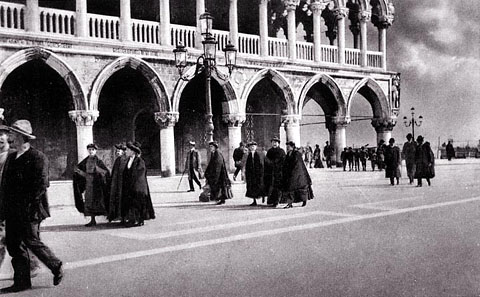 Venice UK Advised to Close Fossil-Fueled Power Plants by 2030The UK's climate watchdog has warned that electricity generation using fossil fuels must be halted in the fairly near future. It wants the UK to set a 2050 target of cutting greenhouse gas emissions by 80%, which is a fairly tall order. It is thought that emissions from aviation and shipping cannot be cut so dramatically, so other sectors will have to reduce emissions by that much more. The body foresees the need for large improvements in energy efficiency and the installation of wind and tidal power. A new generation of nuclear power generators is also predicted. Such a program is expected to cost just 1-2% of the total value of the economy in 2050.There seems to be political will to implement these far-reaching measures in order to avoid climate disturbances. If the report is accepted, the UK target would be the most ambitious legally-binding commitment of any nation and would improve the UK position in global climate negotiations. The 80% cut is to replace a previously-adopted 60% cut. It will include other greenhouse gas emissions, such as methane and NOx. The first approach will be to improve energy efficiency. A decade later, renewable energy sources will be developed. Carbon-capture and sequestration was seen as an option for coal-fired plants. More nuclear power was anticipated. These last measures are, of course, controversial but they are not seen as essential to achieving the 80% reduction. As reported in Carfree Times #51, carbon sequestration is a problematic technology. It was thought that, in the longer term, zero-carbon electricity would be used to power cars and warm buildings.
"End use of fossil fuels in 20 years, UK warned"  Chartres Real ConvenienceLike nearly every nation, Japan has been hard hit by the recent economic misery. One sector of Japan's economy is still flourishing, however. Sales at convenience stores are actually up.These, however, are not your mother's convenience stores. They are very small and very close, and there are a lot of them: 41,000 and counting. At a typical store, you can buy fresh sushi, get your carbon offsets, pay income tax, change diapers, book air tickets, or sip (or swill) a vodka cooler. In addition to the predictable consumables, there are clean toilets, shiny floors, and broadband computers where you can order home appliances, concert tickets, or register for driver's education (if there would be any reason to do so). You can check your luggage for the shinkansen. There's a play area for babies. The convenience store is an American invention, dating all the way back to 1927. As with so many things, the Japanese simply perfected it. The stores are actually fairly small, about 100 square meters (about 1000 square feet), but they're packed with convenience. At some of them, you can arrange for someone to vacuum your apartment. You can drop off your laundry and pay your bills. The fresh food is actually fresh. The Japanese government has even pulled them into earthquake recovery: emergency water and supplies will be distributed from them. They are seen as safe refuges where people can flee in the case of domestic violence. What does this sort of convenience resemble? The concierge services that I propose in Carfree Design Manual would provide many of these same services, plus some additional ones, such as package-room services, tool and bike rentals, storage, and recycling. If we hope to talk people out of their cars, we will have to offer convenience on foot at a level most Americans cannot imagine. The Japanese already know all about it. No wonder that the Japanese, with high levels of car ownership, don't actually drive very much.
"Japanese Stores Take Convenience To a New Level"  Vigo IEA Alters Oil Forecast DramaticallyThe ever-optimist International Energy Agency has warned that massive new investments are required to meet growing demand for oil. The agency also warned of the need for urgent action to cut carbon emissions and halt global warming. This is a radical shift for the agency."Current global trends in energy supply and consumption are patently unsustainable - environmentally, economically, and socially," the IEA said. "Preventing catastrophic and irreversible damage to the global climate ultimately requires a major [decarbonization] of the world energy sources." The IEA is now alarmed by the slow pace of development of oil resources and fears a supply crunch in the coming years. Their forecast for production in 2030 has been lowered by about 10% just since last year, although they still foresee production rising about 20% from current levels (which seems improbable to me). Demand is rising fast in oil-producing nations, and many of them may cease exporting oil in the fairly near future. The report is based on an in-depth analysis of the 800 largest fields. It predicts that producers face a difficult challenge just to maintain production at current levels. New production of 64 million barrels a day is needed, which is equivalent to nearly six times the current production of Saudi Arabia. Investment is lagging well behind what the IEA sees as necessary. The agency forecasts that oil prices could rise again if the global economy picks up. The forecast warns that prices could rise above $100 a barrel by 2015, to $200 a barrel by 2030. (I expect that these price levels will be reached much sooner.) The IEA also warned of a 6-degrees C (10.8 degrees F) rise in global climate by the end of the century. This would be nothing short of catastrophic. The IEA warns that emissions reductions in USA and China are crucial to stabilizing global emissions. The report calls for a rapid shift to a "low-carbon, efficient and environmentally benign system of energy supply."
"Energy agency sounds warnings on oil" 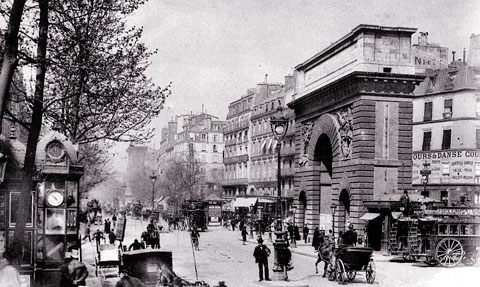 Paris Critical Mass LegalIn a somewhat surprising ruling, five Law Lords in the UK ruled that Critical Mass rides in London are "not unlawful." Friends of the Earth's Rights and Justice Centre challenged police on behalf of a Critical Mass cyclist. The police had claimed that cyclists are liable to prosecution, as organizers do not provide the police with information prior to the event. Critical Mass contended that there are no organizers of this spontaneous event.The court ruled that Critical Mass is a "commonly or customarily held" procession without organizers. The cyclists do not need to inform the police that they are going to ride. About bloody time.
"Read the judgement"
 Luzern Where We Are... and Where We're GoingAn Agenda for President ObamaJ.H. CrawfordWhere are we? What do we want? Where should we be headed? These questions come at the moment of the greatest global crisis in my lifetime. Not since the upheavals of 1968 has there been a similar disquiet among large numbers of people all around the world. The spring of 1968, however, occurred largely in the face of the unjust war in Vietnam. Ultimately, little lasting change resulted, unless it be in the realm of sexual mores. The unparalleled horrors of World War II caused comparatively small changes; ultimately, the United Nations proved to have little more influence than the failed League of Nations, which had been established following the tragedy of World War I. Not since the financial collapse of 1929-1933 has real change resulted from a crisis. In light of these challenges, I offer this agenda to President Obama.The current economic crisis might have been averted had the measures adopted after 1929 not been abandoned shortly before they were once again needed. Are we capable of learning bitter lessons and remembering them, as a society, for more than the span of a lifetime? It appears not, but we must at least make the attempt. This time around we must actually induce permanent change on a global scale. This is a daunting challenge, but nothing less than the fate of the Earth is at stake. If we are to induce lasting and effective change, we must first acknowledge that there are not one but two crises at hand. The more evident one is the ongoing financial crisis. The less evident one is climate change and global sustainability. This problem is actually more serious and longer lasting. There is a joint solution to these crises, and indeed it is the only lasting solution to either of them. If we elect to solve the financial crisis by business-as-usual means, which is the method so far attempted, we will fail to address either crisis in the long term. The current mess is actually a unique opportunity to restructure the economy for long-term sustainability. The End of GrowthThe first hard truth we must accept is that, as the Club of Rome reported 35 years ago, there are limits to growth. These are not economic limits but limits of the physical world. In the first 25 years following the publication of the original report, it seemed that we might have escaped these limits, as new sources of raw materials were found that permitted the global economy to grow at a prodigious rate. Now it has become apparent that we simply cannot continue growth in the manner prescribed by the World Bank and the IMF. Unfettered capitalism is the road to vast riches for a very few people, a better standard of living for many, but not all, people, and massive damage to the ecosystems that sustain life on Earth.The only solution is a completely different approach. We must focus not on material standards of living but on quality of life. For most economists, these are the same: more toys equate to a better life. Deteriorating conditions that have no obvious monetary value are not counted. But as has become apparent in the rich nations, rising material standards of living have led, in the main, to a falling quality of life. We must focus not on goods, the manufacture of which is nearly always accompanied by damage to the environment, but on services, which can provide a livelihood to enormous numbers of people while improving the quality of life and protecting the environment. One service in desperate need is indeed the repair of damage we have already done to the environment. Other services include education and health care (or better, wellness). It is true that billions of people need a higher material standard of living if they are to enjoy a reasonable quality of life. As Ernst U. von Weizsäcker proposed in his 1997 book, Factor Four: Doubling Wealth, Halving Resource Use, we need to make more effective use of resources. I fear, however, that the cheerful notion of doubling wealth (or, more accurately, standard of living) for the world's population is a chimera. If we are able to sustain even current levels of production, I will be surprised. We need to achieve the four-fold resource productivity improvements that Weizsäcker postulated, while holding production steady. Of course, even such a four-fold improvement is not, in the long run, sustainable, but if we can reach this goal in 40 years, we will have a breathing space to consider how ultimately to end the consumption of non-renewable raw materials. Fortunately, improvements on the scale Weizsacker proposed are not really so difficult. It does entail sharp cuts in the most resource-intensive practices, such as extensive personal automobile use, routine long-distance flying, and massive shipments of goods and raw materials around the world. If we are to freeze production at something like current levels, this can only be achieved by an actual reduction in standards of living in the rich nations, unless we are willing to accept that half the people on the planet will live in poverty. Making this change requires graduated taxation in the rich nations. It must become confiscatory for people making very large amounts of money. As late as the end of Dwight Eisenhower's administration, the top marginal US income tax rate was 93%. Howls of protest from the super-rich must not hold us back from a return to such rates. Only by some form of economic justice is it possible to hold consumption steady while allowing poor people to acquire the basic goods they need for a decent life. One of the obvious requirements is recycling, remanufacture, and reuse of virtually all goods. A less obvious requirement is that we return to the manufacture of goods that can be expected to last a lifetime. When I was a child, most of the durable goods acquired by a US household could be expected to last decades. Things like toasters and refrigerators lasted more or less indefinitely and could be repaired when they did finally break. Today the expectation is that families will return to Wal-Mart every few years to replace these goods, now made cheaply in China. This business model is at an end. All manufacturers must be required to take back their products and recover their materials (or remanufacture them) when the end of their economic lifetime is finally reached. This may sound ridiculous to today's younger people, but my parents purchased a toaster when I was a small child and used it until ten years ago. Subsequent replacements have lasted only a year or two. My grandparents bought a refrigerator in about 1925, then a very expensive purchase. As of 2001, that refrigerator was still in use and probably more energy efficient than today's models. If we could achieve this with the rather primitive technology of the time, we should be able to do much better today. Before considering how to achieve these goals, we must take a brief detour through "capital." What is it, what does it do, why is it disappearing now? Capital DestructionThere are two kinds of capital destruction. One occurs only on paper and, despite the misery it may cause, is not so important. In many cases the money is not even gone, it is merely misplaced. It can be recovered by taxation of wealth and prosecution of those who stole it.It is an economic sacred cow that only income be taxed. Even that stalwart socialist, George Bernard Shaw, argued against the taxation of wealth, but it is worth remembering that he had plenty of it himself. The argument runs that taxation of wealth removes capital from the system and prevents economic growth. Even in the face of an end to growth, capital is needed to realign the economy along sustainable lines. However, the US and other governments are busy subsidizing and nationalizing failing industries, and the only way the necessary capital can be raised for this task is from wealth. Whether that capital is raised by borrowing - the current arrangement - or by taxation does not greatly affect the commitment of capital; either way, it becomes unavailable for other application. In the USA and some other nations, housing prices had risen to a level that could not have been sustained by prevailing wage levels and certainly cannot be sustained by the declining wages that the current crisis is inducing. Families are not likely to have enough money to operate oversized dwellings, even if they already own them. As energy costs rise, as they certainly will, the cost of heating these places will become unsupportable. Real estate taxes will rise in most jurisdictions as local and national governments cast about desperately for money to pay debts and to provide work for the unemployed. The net result of this will be declining real estate values, continuing mortgage default, and the destruction of monetary capital. The other kind of capital destruction occurs in the physical world. This occurred when Milton Friedman's theories were allowed to raise US foreign exchange rates so high that US industry could not compete in any market. This resulted in the liquidation of countless US manufacturing companies. By the time the owners bowed to the inevitable, their liquid assets had been consumed. The closing of plants resulted in the liquidation of physical assets: machinery, inventory, and raw materials. These were sold off for a few cents on the dollar and either scrapped or applied to lower uses than formerly. This represents real destruction of wealth. When the Friedman idiocy ended and exchange rates fell to more normal levels, the companies that might have resumed competitive production were simply gone. Most of them have not been resurrected, and most of the work they once did is now done in such places as China. If the housing crisis becomes sufficiently severe, some of the housing stock will decline to negative values. No one will want some houses at any price, and they may ultimately be torn down at a cost that probably exceeds the value of the recovered materials. This has, in fact, essentially occurred in the hardest-hit places in the USA, although demolition of new houses has, as far as I know, not yet begun. (It has been going on for decades in the old centers of US rust-belt cities.) This represents a physical destruction of capital that had been unwisely allocated in the hope of short-term profits. The destruction of capital, especially of physical capital, has long-term repercussions. It heralds an era of hardship, not unlike that of the Great Depression, even though this period may not be as long or as difficult as those years. The greatest problem is that many people cannot find work. Capital has been lost or destroyed and cannot be deployed for the very tasks that might provide work to the unemployed. Great thrift is essential even to survive. Thrift eventually results in the accumulation of new capital. The government may create money to invest in new projects, while accepting that this will inflate the currency. In a time of deflation, inflationary actions are no bad thing. Agenda ItemsI will mention most of these only in passing and then concentrate in the following two sections on short- and long-term changes in areas where I believe my vision has particular acuity.Restore American democracy. The chicanery that occurred in recent presidential elections must end. The nation must reaffirm its commitment to a fair electoral process. Bring lobbying under control. Establish public-only financing of campaigns. Implement run-off elections so that the winner must obtain an absolute majority of the votes. End the war in Iraq. Do it today. Commit American treasure to the reconstruction of a nation that we illegally invaded. Apologize to Iraq and the world. Promise never to do it again. Renew our commitment to the rule of law and to the authority of the United Nations. Improve health care while dramatically reducing its costs. The US economy cannot compete in world markets unless this is achieved. Tackle the very difficult moral issues that relate to the last phases of life. I face these questions every day with respect to my parents. I know for sure only that the existing system is brutal for everyone involved and expensive beyond imagining. Focus instead on health care that sustains health and fosters the healthy growth of children. Tax foods that contribute to ill health. Decriminalize drugs for those over 18. Begin a reality-based program of drug education that will eventually gain the respect of citizens as a reliable source of information. Research prevention and treatment of all forms of addiction and fund treatment programs. Close all privately-owned prisons. Criminal justice is a public, not private, enterprise. Release all prisoners convicted only of drug offenses. Improve education while dismantling the educational bureaucracy. Recent efforts to improve education, at great expense, have only impeded teaching. We cannot test our way to an educated citizenry. Bring the costs of college back within the range of normal families. Re-regulate the public airways. Auction broadcast frequencies to the highest bidders. Limit the amount and content of advertising. Require some semblance of fairness in reporting. Restore innovation. The USA achieved its position as a world leader through centuries of world-class innovation. We are far behind the curve now and need to reinvent our nation, once again. Making the USA the world leader in sustainability is a huge challenge and a gigantic opportunity. Now to some specifics. The great challenge is to end dependence on fossil fuels as rapidly as possible. Climate change must be stopped, and far-reaching action must be started now. The adjustments will often be painful, but most of them will result in a better quality of life in a reasonably short period of time. Short-Term ChangesLet us take "short term" to mean the next eight years. The "long term" items below should be the subject of serious thought starting as soon as possible, but implementation beyond demonstration projects may have to wait a few years. Even so, long-term thinking should influence short-term planning to the extent that foolish projects are not undertaken in haste.End public financing of new housing in rural areas and distant suburbs. Allow mortgage subsidies for existing houses in these areas, but make sure that the government obtains an equity position in the properties. Encourage municipalities to establish urban growth boundaries along the lines of Portland, Oregon. Deny Federal highway funds to cities that fail to comply. Tax air travel tickets. The rate should be modest at first but should increase to high levels in a few years. Stop all expansion of airports. Do not repair or expand the US highway system. Invest that money instead in US railroads, both passenger and freight. If we are to return to reliable passenger service, as I believe we must, it is essential to lay double tracks on all main lines. Given that nearly all of these were once built as two-track lines, this is little more than the cost of laying track and installing signalling. Some bridging will require replacement. Force long-haul freight off the highways with a goal of an 80% reduction in truck ton-miles within ten years. Increase taxation of trucking immediately to cover the costs of the damage it does to roads. Further increase taxes to compensate for its other external costs. Place heavy taxes on air freight, which consumes prodigious amounts of energy given the actual amount of freight moved. This applies especially to agricultural products. Invest in public transport. Fund intensive research into both technical and operational aspects. Make a special effort to develop wireless trams (trolleys, light rail) so that the ugly and expensive wires now required are not a barrier to the rapid installation of affordable new systems. Develop a standard tram that is comfortable, efficient, and economical. Make a similar but smaller effort to improve buses. Fix the Federal Railroad Administration, which is the single greatest barrier to improving rail transport in the USA. The central problem is the philosophy of protecting passengers during wrecks, when the real issue is preventing wrecks in the first place. US passenger rail vehicles are 50% heavier and twice as expensive as they should be because of this approach. Learn from Europe, which has a much better safety record. Commence construction of medium-speed rail systems where these make sense on the basis of ridership gains that will arise as driving becomes more expensive and slower. Speeds of 125 MPH (200 km/hr) are ample when achieved over most of the trajectory; the gains from 200 MPH operation are not large but are very expensive. Commence a large-scale program to reduce energy consumption in all buildings. This labor-intensive work can provide many jobs. Start work on a national system of renewable electricity generation. This probably includes the construction of a high-voltage DC nation grid to move energy efficiently from windmills and photovoltaic farms to consumers. Stop all new construction of coal-fired power plants. Raise taxes on electricity to levels where people will take conservation seriously. This requires at least a doubling of the price over just a few years. Replacing existing lamps can cut electricity consumption by large amounts. Reduce the intensity of street lights and focus their illumination on the ground. Other measures are more difficult and expensive, but the market will take care of the problem in the face of high electricity prices. Tax carbon. The initial rate should be low, perhaps US$0.50 per gallon of gasoline (about $US0.13 per liter), but a phased increase to high levels should be announced now, so that people can begin to rearrange their way of life in accordance with the changes that will eventually be required. A longer-term plan probably requires the implementation of Tradeable Energy Quotas. Quickly phase out the production of ethanol from corn. This will actually save energy and greatly reduce the cost of food worldwide. Improve road safety by an order of magnitude. Set a goal of reducing US highway fatalities to 5,000 a year within ten years. The necessary measures will also substantially reduce fuel consumption. They include:
Allow US automobile manufacturers to go bankrupt. Attempt to salvage at least some of their physical capital by retooling their factories for the production of more useful goods, such as trains and windmills. Set high and rapidly rising requirements for fleet-weighted fuel efficiency by all manufacturers. Something like 30 MPG should be required within two years, rising to 200 MPG within 12 years. That figure may sound absurd, but Volkswagen has already built a prototype that exceeds it. Long-Term ChangesThe following proposals will take generations to implement. Seed money should be allocated as soon as possible to study the ways and means of achieving them.Sustainable agriculture is the only basis on which we can move forward. This will require an end to the use of petroleum to produce and ship food. I expect that large improvements can be achieved in relatively short order, but the final elimination of petroleum inputs is a daunting task that we should begin now. Improve the quality of urban life by rapidly reducing the impact of cars on cities. Institute stiff congestion charges in all urban cores, along the lines of The City in London. End right-turn-on-red in urban areas. Install cameras to enforce bicycle and pedestrian rights at intersections. Make drivers presumptively responsible for any collision with a pedestrian or cyclist. Disable car horns in urban areas. Focus on the redevelopment of existing urban cores, and do so in a way that is consistent with an eventual change to entirely carfree streets. Change zoning everywhere to permit all compatible uses in all areas that are subject to development. End the separation of uses first required by the US government in the late 1930s. Densify near-in suburbs by building higher and closer. Plan to build new housing in what is now the street. Build public transport from city centers into these areas. Prepare the public for the need to occupy smaller dwellings. We cannot sustain 1000-square-feet-per-person. Provide incentives for subdividing large houses in near-in areas. Plan to recover raw materials, to the extent possible, from the demolition of McMansions in distant suburbs. Ban any further construction of shopping malls in peripheral areas. Require all new commercial development to find sites in the urban core, where good public transport service can be provided. Build carfree cities on a large scale. Great effort should go into reconstructing existing cities to operate without cars. The effort is immense and can keep millions of people employed for decades. Use federal lands to build land-grant cities, following the tradition of granting federal lands to achieve public purposes. Install streetcars in cities with a population of more than 50,000. Keep cars out of their way, so that they can run to schedule. Charge no fare for these services. Attempt to install these systems using a standardized wireless light-rail vehicle. Begin development of Interstate Rail as a use for what will become excess capacity on the Interstate Highway system. This will provide 100 MPH (160 km/hr) passenger and freight service on an entirely new rail network. Right-of-way costs would be very low. Begin construction within eight years. Restore most of the rail network that was in place in 1918. The rights-of-way still exist in most cases, so the cost would be moderate. Service will always be comparatively infrequent on these routes, but they will be a lifeline for people in semi-rural areas as driving becomes too expensive. Develop a new generation of aircraft that is slower (say 250 knots) and probably smaller than the aircraft now in use. Fuel efficiency must be dramatically improved and emissions into the stratosphere correspondingly curtailed. Liquid hydrogen fuel is the most promising approach. The total annual passenger-miles must decline sharply from current levels. Transcontinental and transoceanic flights will probably continue to be necessary, albeit at a greatly reduced level from today. Begin work on a system to produce transport energy from sustainable sources. There are a number of approaches possible, but none is yet developed to the point where we can plan to employ it. This could include some fermentation of agricultural products, as in the production of ethanol from sugarcane wastes in Brazil. Do not begin any project that is not clearly sustainable in the long run. Electrified railways are the most promising approach, but some form of liquid fuel is probably essential. I do not foresee a complete end to automobile usage, although much of it might be by short-range electric cars recharged from the grid when parked. I hesitate to say this, but I believe that work should be done on prototype nuclear power plants. Only a few demonstration units should be built, and their design must include effective plans to deal with nuclear wastes. There are methods to do this, but they are extremely expensive. Still, I am concerned that the transition to sustainable energy might not be achieved without nuclear energy as a bridge. Therefore, new, safer plants should be devised with the intention that they will only be used if they become absolutely essential. Other plans should be in place to avoid that eventuality. David Fleming believes that the exhaustion of fissile materials is a more serious issue than I had thought. It can be argued that the only way to get the atomic genie back in the bottle is to burn the world's entire supply of plutonium in nuclear reactors. Lay plan to move into the future without actually building more nuclear power plants. ConclusionWe have the means to attain a more peaceful, more sustainable, and more joyful world. The changes needed are larger than anything ever seen in history. They dwarf the Apollo project of the 1960s. If you wish to leave your mark as one of the great American presidents, I believe that you must set the nation on the road to this more hopeful future. Do not fear to oppose the interests of the rich. You need instead the enthusiastic support of the vast majority of the American people. You have already demonstrated once that you can achieve this. Now the real work begins. You must do it again. If you succeed, you will also inspire the rest of the world.
|
Books & Films
From the publisher's blurb: Americans are voting with their feet to abandon strip malls and suburban sprawl, embracing instead a new type of community where they can live, work, shop, and play within easy walking distance. In The Option of Urbanism visionary developer and strategist Christopher B. Leinberger explains why government policies have tilted the playing field toward one form of development over the last sixty years: the drivable suburb. Rooted in the driving forces of the economy—car manufacturing and the oil industry—this type of growth has fostered the decline of community, contributed to urban decay, increased greenhouse gas emissions, and contributed to the rise in obesity and asthma. Highlighting both the challenges and the opportunities for this type of development, The Option of Urbanism shows how the American Dream is shifting to include cities as well as suburbs and how the financial and real estate communities need to respond to build communities that are more environmentally, socially, and financially sustainable.
From the publisher's blurb: Public space and street design in commercial districts can dictate the success or failure of walkable community centers. Instead of focusing our efforts on designing new "compact town centers," many of which are located in the suburbs, we should instead be revitalizing existing authentic town centers. This informative, practical book describes methods for restoring the health and vibrancy of the streets and public spaces of our existing commercial districts in ways that will make them positive alternatives to suburban sprawl while respecting their historic character. Clearly written and with numerous photos to enhance the text, Creating Vibrant Public Spaces uses examples from communities across the United States to illustrate the potential for restoring the balance provided by older urban centers between automobile access and "walkability." In advice that can be applied to a variety of settings and scales, Crankshaw describes the tenets of contemporary design theory, how to understand the physical evolution of towns, how to analyze existing conditions, and how to evaluate the feasibility of design recommendations. Good design in commercial centers, Crankshaw contends, facilitates movement and access, creates dynamic social spaces, and contributes to the sense of a "center" - a place where social, commercial, and institutional interaction is more vibrant than in surrounding districts. For all the talk of creating new "green" urban spaces, the ingredients of environmentally aware design, he points out, can often be found in the deteriorating cores and neighborhoods of towns and cities across the United States. With creativity, planning, and commitment, these centers can thrive again, adding to the quality of local life and contributing to the local economy, too.
 Frankfurt Hot New LinksThe links below will open in a new browser window:
The Traffic Guru by Tom Vanderbilt 80 in 50 Scenarios for dramatic reductions in transport energy consumption, from Sustainable Transportation Energy Pathways Streets: Utilitarian Corridors or Livable Public Space from The Oil Drum
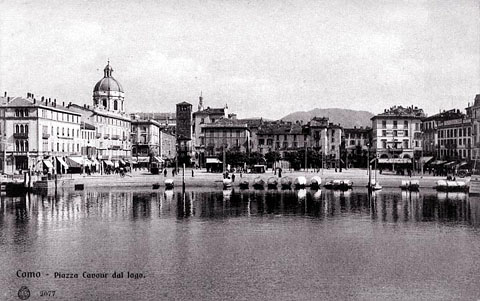 Como About Carfree Times
Next Issue
Subscribe to Carfree Times
Statement of OwnershipCarfree.com is wholly owned by Joel Crawford, the legal name of author J.H. Crawford. Its operation is financed by J.H. Crawford, with the help of some generous donors since 2004. It generates no revenues directly but does help support book sales. Carfree.com accepts review copies of books but makes no commitment to review them. J.H. Crawford receives no commissions from the sale of books mentioned on Carfree.com. The views expressed at Carfree.com are those of J.H. Crawford, except for articles, letters, and editorials that carry the names of other authors. The inclusion of these signed texts is at the sole discretion of J.H. Crawford, who does not necessarily agree with the views expressed. All other content, except quoted material, is written by J.H. Crawford. E-mail announcements of new issues of Carfree Times are mailed to approximately 800 subscribers. A rough estimate of first-year circulation for each new issue is 5000. All the issues ever published are still being read. |
| Editor | J.H. Crawford |
| Send e-mail | |
| URL | http://www.carfree.com/
|
Back to Carfree.com
Carfree Times Home
Back to Carfree Times Issue 51
Forward to Carfree Times Issue 53
About the book: Carfree Cities
E-mail
carfree.com
Copyright ©2008 J.Crawford


